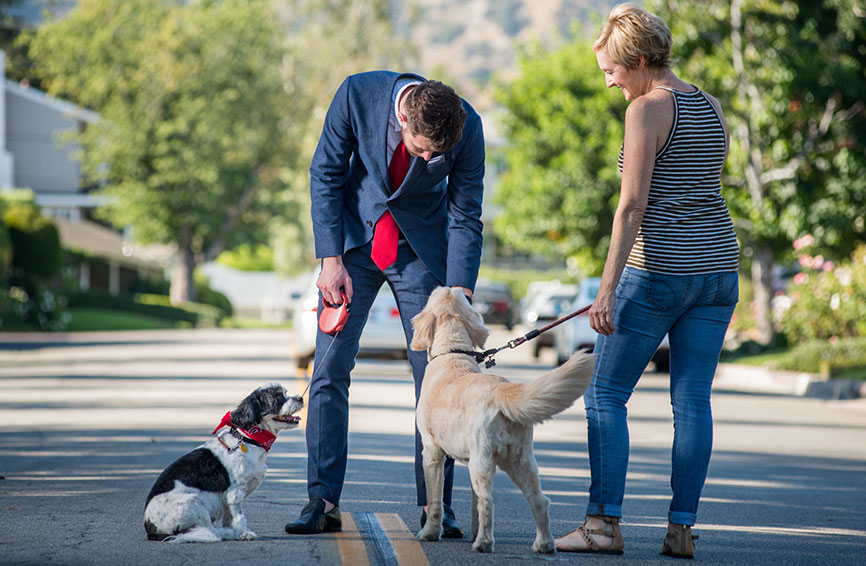Key Takeaways
- If your dog is growling, barking, snarling or snapping at a new person when they approach, he is fearful and will need training to lessen his anxiety and become comfortable with new people.
- You can condition your dog to be less fearful by identifying his triggers and then creating a positive experience connected to the trigger.
- Until your dog is less fearful, keep a distance from strangers so you don’t trigger anxiety and potential problems.
Table of Contents
To put it mildly, some dogs are not particularly fond of humans they do not know. They may not like approaching or even being around them and can behave in concerning ways when confronted with a stranger. This is sometimes labeled dog aggression or reactivity, but it’s not the dog’s fault.
If your dog is growling, barking, snarling or snapping at a new person when they approach, it is not because your dog is a jerk; he is likely AFRAID (for various reasons, possibly completely unknown to us) and trying desperately to get that person to back off. If your dog is showing behaviors towards people that make him appear to be an aggressive dog—these are actually fearful behaviors—below are steps to take for approach and handling.
Before starting, you should have a specialized counterconditioning and desensitization training plan for your dog’s individual triggers. A brief explanation of counterconditioning and desensitization is below but please seek professional help from a positive trainer or veterinary behaviorist to implement a full training plan.

How to train an aggressive dog in a ‘stranger’ scenario
Do NOT have a stranger give your dog treats. Often people make the mistake of having the stranger offer the dog treats but if your dog really likes treats, you may be luring him to the stranger with the food and thus creating conflict in your dog (“I want that treat but don’t really want to get close to that scary human”). Once your dog gets up to the stranger, he may take the treat but find himself too close for comfort and even more frightened.
Initially, any treats should be coming from you when the unfamiliar person appears. If the “stranger” is someone who you do eventually want to be in your dog’s life, once your dog is comfortable (read his all-important body language!), then you can start having the guest toss treats away from their body.
Gradually work closer only when your dog chooses to get closer without the lure of a treat. Your dog should always be able to initiate the interaction and be free to choose to get away if he wants.
Keep in mind that all interactions and handling should allow for the least amount of fear, anxiety and stress placed on your dog. Here are some steps:
- Observe body language and stress signals before contact and throughout the interaction, as your dog may change his mind at any time. Body language should be loose and wiggly. If you see stiffening or stillness, tucked tail, side-eye or hard stare, do not get closer or allow the stranger to approach.
- If you are in your home, you may put your dog in another room when the visitor arrives and then have the guest already sitting when you bring your dog out. Most dogs will be more comfortable with a stranger in their house/space if the person is seated and still (but relaxed) first. Any movement on the human’s part (standing or walking) can trigger the dog and scare him, even if he was fine with the human sitting before.
- Go slowly. Your dog decides the pace. The new person should completely ignore your dog. They should turn their head to the side, avoid direct eye contact, and make themselves “smaller” by sitting, standing sideways or crouching. The guest should not look at, talk to, or reach out to touch your dog. If the visitor is seated before your dog enters the room, have the person do something else like read or look at their phone so they are not tempted to look at, or engage with your dog.
- Wait and let your dog approach the newcomer first. Give your dog the choice to interact or not. Let your dog come and sniff the stranger and retreat as he wants. He may do this several times; allow him to check the visitor out without the person reaching for him immediately.
- Sniffing does not mean your dog is giving consent to touch or pet them. Wait for body movements from your dog that solicit the stranger’s attention or touch, such as pressing his head or body into the person’s hand or body. Your dog should have a relaxed, loose body posture.
- Once your dog is comfortable with the new person’s presence, have them throw the treats away from his body so that your dog does not need to come right up to them to get the reward. If your dog doesn’t want to approach the stranger, don’t try to lure him closer. As we’ve mentioned, luring sets up a conflict for the dog. He may want the food but doesn’t want to be near the stranger. As the dog gets more comfortable approaching the person, he can slowly toss the treats closer to him. Ask the new person to minimize his arm movement or move slowly since an arm swing can be threatening to a dog.
- You can use a counterconditioning and desensitization protocol for any of your dog’s “triggers” or the things he is scared of, such as other dogs, cars or the vacuum cleaner.
How does counterconditioning and desensitization work for dogs?
Basic Counterconditioning/Desensitization Protocol:
The goal is to change how the dog FEELS about the trigger (a stranger) by giving them a positive association. We are not “training” the dog to do anything. Think of counterconditioning as when a stranger appears, great things happen to Fido.
- First, identify your dog’s triggers. Examples: a stranger entering their space, a stranger’s presence in a room, movement from sitting to standing or walking across the room, hand coming toward the dog’s body/head/feet. Certain people (possibly children, men, people holding objects) may trigger your dog but not others. Your dog also may be OK with people in a certain environment (off leash, away from your home) but not when in your home or when the dog is on a leash (where they are “trapped” and can’t get away). When you see someone who is a trigger (stranger) for the dog, and you are in an environment where the dog is uncomfortable, stay at a distance where the dog is still comfortable and give a high-value treat.
- Continue to pair the treat with the trigger/stranger, always staying at the level where the dog is relaxed, then gradually get closer.
- Examples:
- Stranger in room = treats appears. Repeat until dog does not care about stranger in room.
- Stranger stands = treats. Repeat as above.
- Stranger moves across room (sideways, not directly towards dog) = treats. Always repeat the steps until dog “doesn’t care.”
- Stranger takes a step towards dog = treats.
- Stranger takes two steps towards dog = treats.









